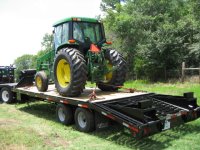kevinj said:
Sooo...................how do you chain down safety?

Multiple chains.
Grade 70 DOT approved chains, consider larger than the minimum rating.
Good load binders (boomers) Use a scrap of single strand electrical wire or a stout string to tie the load binder lever closed (over center locking type not ratcheting.) Ratcheting are good also and do not need a safety wire.
Strong attachment points on trailer and equipment.
1. Front chains should pull forward as well as down.
2. Rear chains should pull backwards as well as down.
3. All chains should pull partially outward as well.
If you use stake pockets or similar for chain hook attachment points, pass the chain through the pocket vertically downward and then bring the hook up on the outside of the pocket and hook the hook on the top of the stake pocket. If for any reason the chain goes slack the hook will not fall away and allow the chain to wander off into the road, under a wheel, or whatever.
After securing the load and before travel down the public road, accelerate a bit, swerve a bit left and right, use your brakes a bit, and then stop and check all chains for tightness, retensioning as required. If going more than a few minutes or a few miles, stop and check the chain tension in a few minutes or miles (lather rinse repeat until you are sure the load is not shifting and then you can decrease but not eliminate your checking.)
Some folks like to attach the chains to be used on one end of the machine and then move it under its own power to tighten those chains and then use the binders to tension the chains at the other end. This elliminates the need for binders at both ends and cuts the binder count in half.
When properly snugged down you may see some deflection of the pneumatic tires. I like this. it helps keep the chains tight.
Try to remember you have a load with a high center of gravity and do not make any abrupt lane changes or take curves as fast as they are marked (yellow diamond speed advisory signs)
Don't follow closely and be prepared for people to pull in front of you and slam on their brakes. It will happen.
Pat

